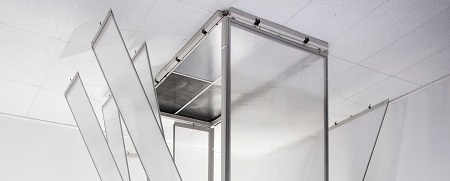Fire Suppression for Aisle Containment
In my last blog, we talked about hot-aisle and cold-aisle containment as an ideal solution for keeping equipment cool and saving energy in today’s high-density virtualized data centers.
Depending on the location of the data center and location of the containment system within the data center, some form of fire detection and/or fire suppression is required inside the enclosed aisle.
Let’s take a closer look at fire detection and suppression in the data center and how aisle containment systems can impact the requirements.
A Different Kind of Room
An aisle containment system essentially creates a room within a room, and every room needs fire suppression. But the room that is created with aisle containment is also a different kind of room.
In addition to containing highly critical and expensive equipment, airflow patterns and velocity are altered in the containment area. This changes the normal movement of smoke and can dilute smoke, which can impact adequate smoke detection. This is why very early warning aspirating smoke detection (ASD) like VESDA systems are installed in most data centers.
Unlike common passive spot smoke detectors, ASDs actively draw air through a network of pipes to detect smoke by a centralized sensitive laser detection unit. Installing a VESDA system with ASDs at the return air inlet to sample the hot return in the containment aisle in one practice that can make sense for containment systems.
The Codes Require It
The National Fire Protection Association (NFPA) recognizes data centers as high airflow environments, and has even released a new report titled, "Validation of Modeling Tools for Detection Design in High Air Flow Environments." The report provides guidance for the fire protection of IT equipment and telecommunications facilities.
In a nutshell, NFPA 75 requires that automated information storage system units (i.e., a containment area) containing combustible media shall be protected within each unit by an automatic sprinkler system or gaseous agent extinguishing system with extended discharge.
The NFPA also states that sprinkler systems in computer rooms shall be maintained in accordance with NFPA 25, Standard for the Inspection, Testing and Maintenance of Water-Based Fire Protection Systems.
Removing the Barrier
While new data centers are designed with fire suppression systems that comply with the code, one issue with existing data centers that are retrofitted with containment systems is that they often block appropriation fire suppression dispersion.
In a retrofit situation, the panels used in an aisle containment system can create an obstruction for the protected space and can also alter existing sprinkler system or clean agent dispersion in the area outside of the containment area.
Most containment systems feature some type method for removing the barrier in the event of fire. Some panels are thermally activated to fall or shrink. The problem with these systems is that the fire must reach a certain temperature before the panels are activated. In other words, they require a large enough fire to eliminate the barrier.
Furthermore, many data centers use clean agent fire suppression, which are typically activated by smoke rather than heat and the barrier needs to be removed prior to release of the agent. Another concern with thermally-activated panels is that they can pose a safety hazard when they fall, and they have to be replaced after the event. There is also no real way to test these panels.
Aisle containment systems that are controlled by smoke and fire alarm systems are much better equipped to ensure early and immediate obstruction of critical fire suppression systems.
 Ideal for new data centers and for retrofitting an existing data center, the new Belden Aisle Containment System can interface with all types of smoke and fire alarm systems. The lightweight panels simply angle away rather than falling or shrinking, preventing the potential for hazards or equipment damage and avoiding replacement costs. They are also fully resettable after an alarm event or testing.
Ideal for new data centers and for retrofitting an existing data center, the new Belden Aisle Containment System can interface with all types of smoke and fire alarm systems. The lightweight panels simply angle away rather than falling or shrinking, preventing the potential for hazards or equipment damage and avoiding replacement costs. They are also fully resettable after an alarm event or testing.
If you have any questions on fire suppression in the data center, schedule a call with one of our experts!
